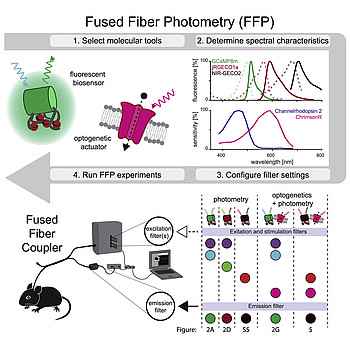Sie befinden sich hier
Inhalt
29th March 2023
Scientists from the Department of Neurophysiology at the Mannheim Medical Faculty of the University of Heidelberg have developed a flexible and versatile system that allows the study of brain function in many ways. Its low-cost and simple implementation makes it accessible to many laboratories worldwide. The fused fiber photometry (FFP) system couples multicolor photometry with optogenetics.
An important approach in brain research is to control and measure the activity of individual brain areas in order to be able to draw conclusions about their function. Optogenetics methods are being used to test the function of precisely defined cell populations using optical methods. For this purpose, light-sensitive switches are built into the nerve cells, which make it possible to switch their activity on and off by means of light and thus to draw conclusions about their function. Neurons and neuronal circuits can be precisely manipulated and studied in this way.
Brain functions can be measured using both electrophysiological and optical methods. However, both techniques require expensive, sophisticated equipment, generate enormous amounts of data, and analysis is often complicated. A simple alternative to these very sophisticated methods is fiber photometry, in which neuronal activity is measured using an optical fiber. Fiber photometry is commonly used to detect calcium dynamics in genetically defined neuron populations and to draw conclusions about brain activity. Fluorescent calcium indicators are used for this purpose.
Fiber photometry allows conclusions to be drawn about brain activity even in deep and hard-to-reach brain areas in freely moving animals and is also straightforward in terms of data analysis. Therefore, photometry has enjoyed great popularity in recent years and has contributed significantly to the understanding of brain function. At the same time, the molecular toolbox of genetically encoded fluorescent biosensors has been constantly expanding. In addition to the variety of calcium indicators, other genetically encoded biosensors have been developed that measure membrane potential, neurotransmitter release, pH, or various cellular metabolites.
The versatility and applicability of fiber photometry is thus constantly increasing. However, being able to implement these new molecular tools and combine them with optogenetic actuators within an experimental approach poses significant technical challenges. Currently, different assemblies of optical hardware are required for optical stimulation and readout, as well as for combining multiple biosensors in one experiment.
Scientists at the Department of Neurophysiology in Mannheim, led by Professor Dr. Simon Wiegert, have now developed a flexible and versatile system in which fiber photometric recordings can be easily combined with optogenetic manipulations in a single device. At the heart of the FFP system is a multimode fused fiber optic coupler that provides both light delivery and light collection. Combined with a multicolor light source and appropriate emission filters, the approach offers great flexibility in experimental design and facilitates the application of new molecular tools at minimal cost.
The FFP system can transmit light of any wavelength. Accordingly, fluorescent indicators with any spectral characteristics can be used. "The system could revolutionize the study of brain function because it is simple, flexible and inexpensive, extending the range of fiber photometry far beyond the capabilities of conventional standard setups," says Simon Wiegert.
Original scientific publication:
A flexible and versatile system for multi-color fiber photometry and optogenetic manipulation
Formozov A, Dieter A and Wiegert S.
2023 March 27, Cell Reports Methods, 3:100418
DOI: https://doi.org/10.1016/j.crmeth.2023.100418
Video on YouTube:
FFP system assembly: https://youtu.be/-qNlV_4r8Jw
Press release at the Medical Faculty Mannheim (German language):
29.03.2023 Fused Fiber Photometry (FFP) – ein flexibles, vielseitiges und kostengünstiges System zur Aufzeichnung neuronaler Aktivität
Contact for scientific information:
Prof. Dr. Simon Wiegert
Chair of the Department of Neurophysiology
Co-director of the Mannheim Center for Translational Neuroscience
Medical Faculty Mannheim
University of Heidelberg
Ludolf-Krehl-Str. 13-17 / Tridomus C
68167 Mannheim / Germany
Phone +49 621 383-71405

